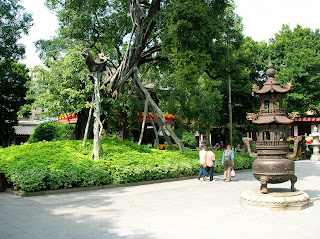After visiting Shamian Island, we hopped on the subway headed for Guangxiao Temple (in English, it means Bright Filial Temple). It’s the largest Buddhist monastery complex in Guangdong Province with a long history and with great influence. It was originally a palace of a Prince during the Western Han Dynasty (206 B.C.-24 A.D.). In the Three Kingdoms Period, it became a teaching academy of Yu Fan, an official as well as scholar of the I-Ching, who came here in exile. During the Longan Reign of the Eastern Jin Dynasty (397-401), a Buddhist hall was built on site by a monk. The current name of Guangxiao Temple was established during the Shaoxing Reign of the Song Dynasty (1151). The Temple was severely damaged as the Manchurian soldiers marched southward and the city was bombarded. Under the rule of Emperors Shunzhi and Kangxi, it was somehow restored, but damage was done to it during the period from the late Qing to the Republic of China as it had long been occupied by cultural, educational, and military organizations. Due emphasis was attached to the development of the Temple after the Republic’s founding. In 1986, it was approved to resume religious activities and opened to the public. The statutes and buildings were restored and expansion took fold. It’s the Home Temple of Chinese Zen Tradition and holds a significant history of Chinese Buddhism.
The above was just a snapshot of information I took out of a pamphlet they provided us. I have also read that this Temple/complex is older than the city itself. The complex is laid out in typical Chinese fashion, facing south on a north-south axis. There was also a vegetarian restaurant on site but we didn’t eat there. We thought it was a little too expensive, so we ate lunch at a little noodle restaurant on the road that leads/ends at the Temple. Outside the Temple, there are Chinese begging for money all over the place though the police/guards will shoo them away if the beggars get too close to the Temple. But it was a cool place and was a gorgeous day. You certainly do not come to these Temples in China if you do not like the smell of incense. We spent about an hour here and then headed back to the subway to go to a park…











just did a whole page reply and it disappeared. Really loved this blog. Gonna try to find what i wrote. went to look at the pics again..poof...reply gone..
ReplyDeleteGOOD PIC OF YOU. GREAT STATUES. YOU COULD SEE THE INSCENCE RISING. NICE GREENERY AND ALL THE FOO DOGS AS GUARDIANS.LOVED THE LANTERNS, PAGODA, AND SILKS. WOULD LOVE TO HAVE SEEN THIS. I DONT KNOW IF WHEN THEY LIGHT THE STICKS THESE ARE CALLED JOSS STICKS.MANY GREAT PRECEPTS IN BUDDHISM BUT HARD TO FOLLOW. JUST BOUGHT A WONDERFUL BOOK FOR ME AND MARYLY ON BUDDHIST MEDITATIONS AND THOUGHTS. VERY CALMING AND PROFOUND. GREAT POST.
ReplyDelete